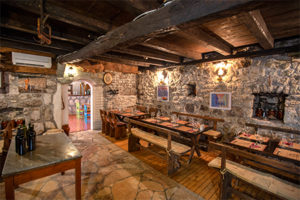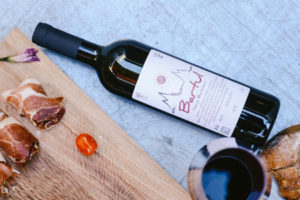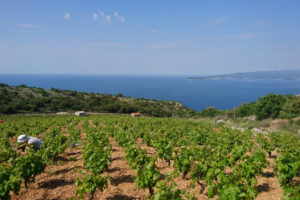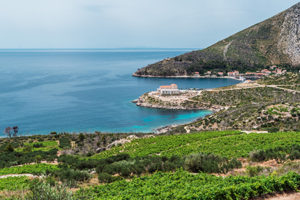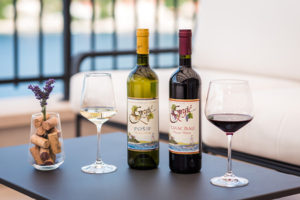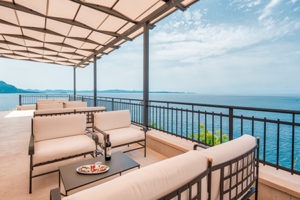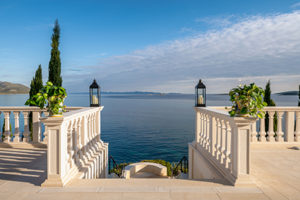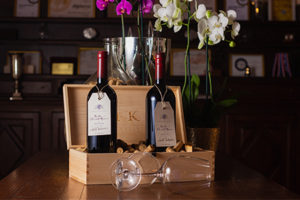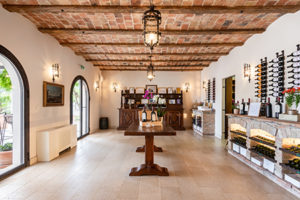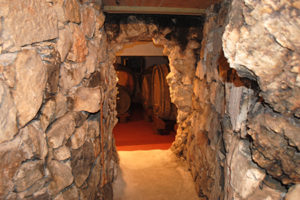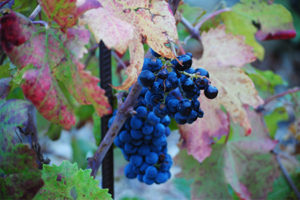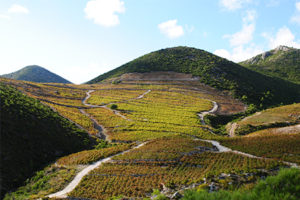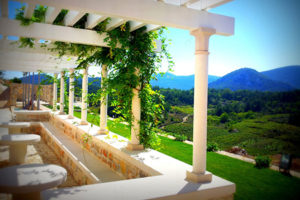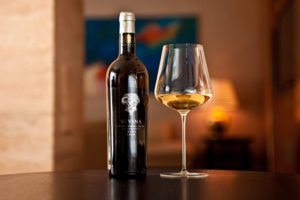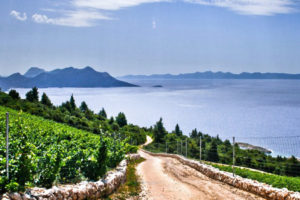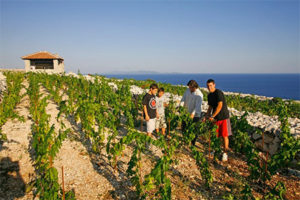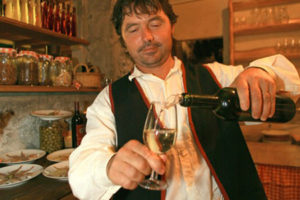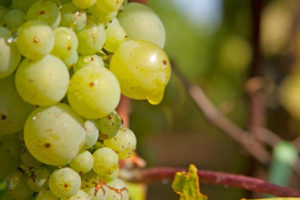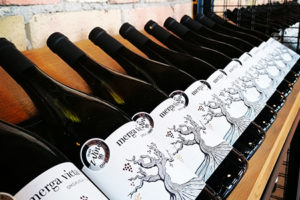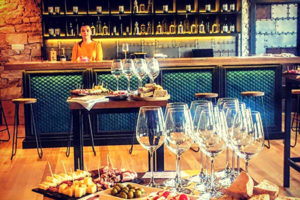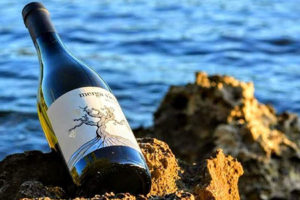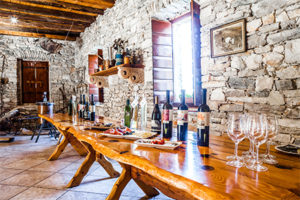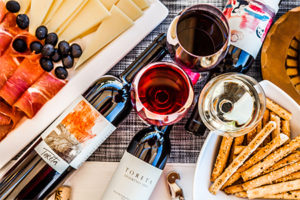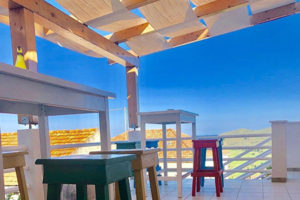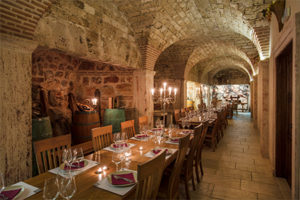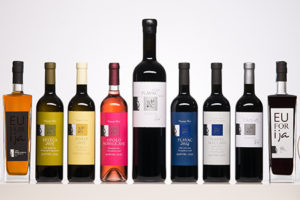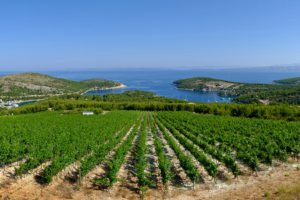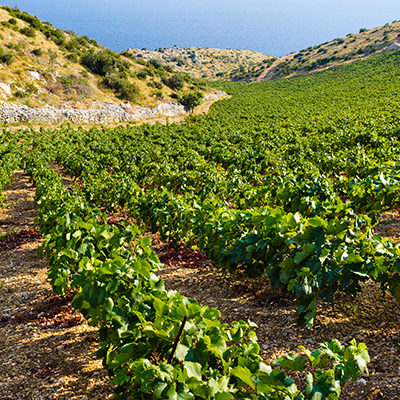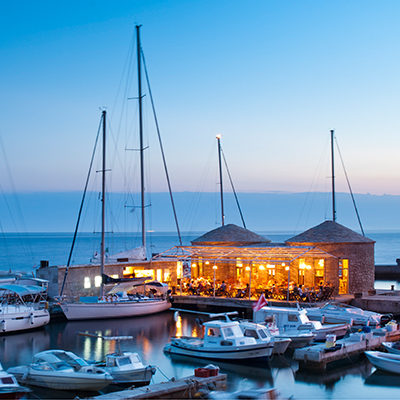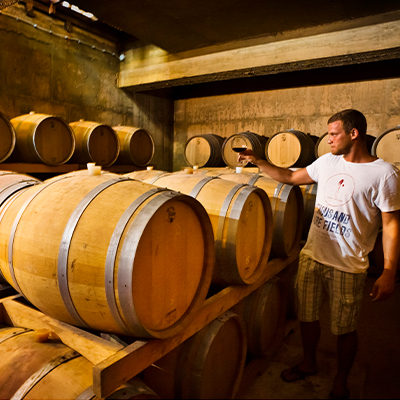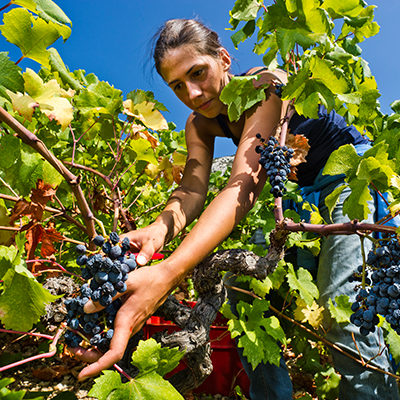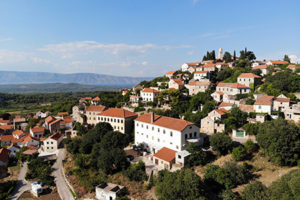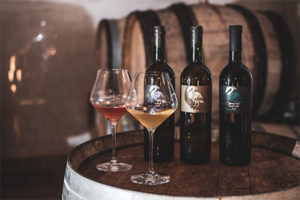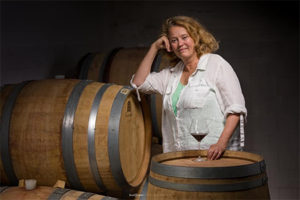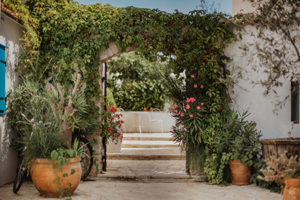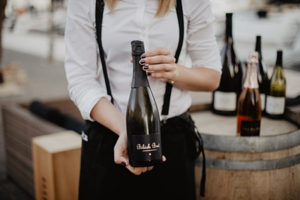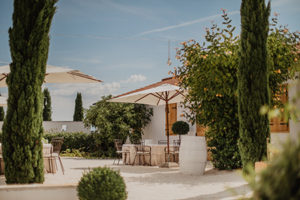Dalmatia Wine Region
The southernmost region of Croatia, Dalmatia, is most often recognized as home to Dubrovnik, the iconic UNESCO city whose walls cradle its preserved stone buildings and rows of terraced stairs; a city which evokes an indescribable feeling of wonder that electrifies even the most seasoned world travelers.
Dalmatia runs from north to south along the coast, and across to the eastern border of the country. Beyond Dubrovnik, the diverse region contains within it the cities of Split, Šibenik, and at its northernmost area, Zadar, as well as the adjacent islands. The landscape and climate of the region produce diverse terroirs, including smaller sub-regions and micro-climates. It is no wonder that so many native grapes are found here.
Native whites include the full-bodied Pošip, originally from the island of Korčula and lemony Debit. Zinfandel, called Tribidrag or Crljenak Kaštelanski depending on the locality, is well known beyond Croatia.
The red grape Babić, with its firm tannins and sour cherry notes, is found in central and northern Dalmatia while Plavac Mali dominates the Pelješac Peninsula and southern islands, with its savory, figgy profile.
Events – FestiWine – Dubrovnik’s annual wine festival, takes place in March or April, as a celebration of local winemakers and region varieties. The central event of the Festival is the Wine Exhibition. Guests can take part in lectures and wine tastings, as well as wine workshops dedicated to the autochthonous varieties of Dalmatia. In what is known as “Blind Date,” blind tastings are paired with oysters of Ston, a native delicacy. The festival includes a gala and awards ceremony.
As we journey through the region, and share some of our favorite wineries, we travel from South to North, venturing away from the mainland onto islands, then back to the mainland again, to pronounce our favorite winemakers and tasting experiences that delight the senses with innumerable pleasure.
For the latest up-to-date information, contact our team of specialists at Tasteful Croatian Journeys
Pelješac Peninsula
The Pelješac Peninsula is a landscape of mercilessly steep, undulating rocky hills that serve as an anchor for its fertile soil, unexpectedly ripe for creation. At once rugged and lush, vineyards cover a significant amount of the Pelješac peninsula, from Ston in the south all the way to Orebić in the northwestern end of the peninsula.
The unique features of the severe landscape create an optimal environment for flavorful grapes. Only 4 miles wide, the sea is an essential element for the nourishment and moisture of the soil here. An arid climate with reliable sea salted breezes allow for vines that are low in yield, but very rich in flavor. The landscape and location in the southern Adriatic mean the vines enjoy great sun exposure
The landscape that protects and sustains the vine in turn produces a punishing task for winemakers. Harvesting the sloped vineyards requires human hands, as machines cannot oppose the force of gravity the pulls at these inclines. Grape pickers use harnesses to dangle from the hillside as they carefully gather the fruit.
The most famous grape is undoubtably Plavac Mali, in fact it was the first in Croatia to have its own appellations, Dingač and Postup, both located on the Pelješac peninsula. A red wine grape variety, Plavac Mali translates to “small blue,”, the name given due to the appearance of the grape. These grapes thrive on sandy, south-facing slopes above the sea. In this environment, Plavac Mali gives low grape yields, leading to concentrated wines, very deep in color, rich, and full-bodied. The robust wine it produces is higher in both alcohol and tannin, with lower acidity, fruity and full of flavor with notes of blackberry, cherry, smoke and spice. Plavac Mali wines have excellent aging capabilities.
The magnificent and pastoral Pelješac peninsula brings visitors to the heart of the winemaker’s journey, evocative of older times. The wines of the Pelješac are all about sea, sun, stone and really hard work… and they are worth every drop.
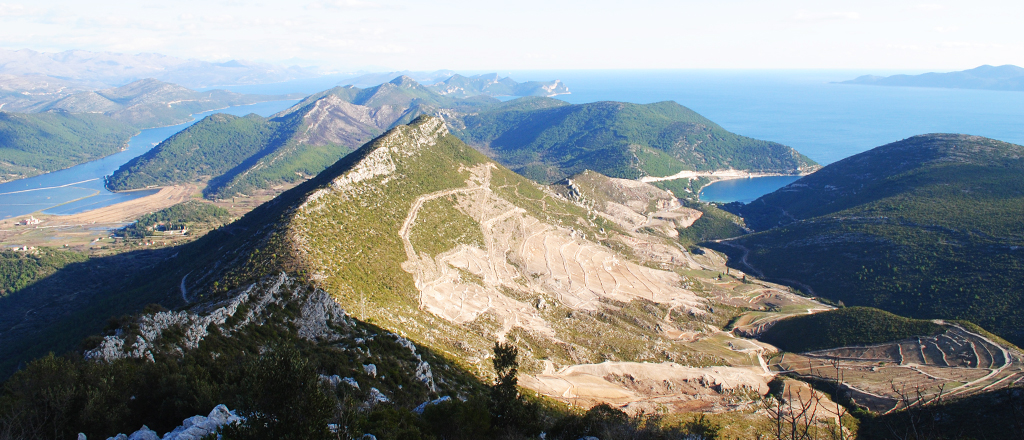
Vinarija Bartulović
Pelješac Peninsula, Dalmatia Region
About:
- Traditional viticulture, dry farmed with no insecticide or herbicide. Annual production around 14,000 bottles – 80% Plavac Mali (red) 20% Rukatac (white).
Why we love it:
- Family traditions meet modern technology and mix in sustainable practices for an exciting wine story. Natural fermentation without filtering, the wines are true representatives of the local soil and climate.
Experiences:
- Visit the winery and Konoba (local tavern). The Dalmatian Konoba is on the site of the former wine cellar and prepares various local specialties, cold appetizers, and main dishes for unique gastro-enological experience.
Grgić Vina
Trstenik, Pelješac Peninsula, Dalmatia Region
About:
- Established in 1996 by Miljenka “Mike” Grgich, with his daughter Violet Grgich, they produce the region’s most notable varieties, Plavac Mali (red) and Pošip (white). All wines made in at Grgić Vina have been judged to be “Vrhunska Vina” (top premium wines), and his 1996 Plavac Mali has twice been recognized as the best Croatian red wine on the market.
Why we love it:
- Mike Grgich, the legendary Napa Valley winemaker, started the winery to produce the finest wines from native Dalmatian grapes, and they seek to represent these two wines in a very authentic way.
Experiences:
- The winery has the most stunning panoramic view of the Adriatic Sea and is open daily. We suggest an unhurried experience, tasting the two local wines offered and enjoying the beautiful view.
Korta Katarina Winery
Orebić, Pelješac Peninsula, Dalmatia Region
About:
- The winery turns out 60,000 bottles a year of wines made from local native varieties, Plavac Mali (red), Pošip (white) and Rukatac (white), using the best quality French oak barrels for wine maturing. The wines have received a number of accolades along with high ratings.
Why we love it:
- The passion of American philanthropists, Lee and Penny Anderson of Minnesota, the winery and luxury seaside villa in the town of Orebić are part of their mission to educate guests about Croatian wine, cuisine, and culture.
Experiences:
- Three choices for tastings and tours; Guided wine tasting and educational tour (1 hour), Gourmet Tapas & wine tasting with tour (1.5 hours), or the Five course wine & culinary paring with winery tour (2.5 hours). Reservations are required.
Miloš Winery
Ston, Pelješac Peninsula, Dalmatia Region
About:
- With a focus on ecological production and the autochthonous grape variety of Plavac Mali, they specialize in producing different types of high-quality wine of the Plavac mali cultivar. Miloš has gained international recognition.
Why we love it:
- The oldest family owned winery on Pelješac, with a unique story to tell of wine, land and family. Immediately after the fall of communism, Frano Miloš began purchasing land from the state-owned wineries, and developing his delicious ‘Stagnum’ range of wines.
Experiences:
- Stop in to taste the mostly dry reds in their sunlit tasting room built into a mountainside, open daily. Classical wine tastings include a wine presentation on all the specifics of the winemaking process and a visit to the old part of the cellar.
Saints Hills’ Winery
Pelješac Peninsula, Dalmatia Region
About:
- A family boutique winery, they successfully present Croatian wines and native varieties with modern production and a respect for nature. The winery produces four wines from different regions around Croatia. Each of their three vineyards and their olive orchard has been named after a saint.
Why we love it:
- The location is inland on the peninsula with stunning vistas, guests will understand the way the landscape shapes the winemakers process here and appreciate their very difficult work. Beautiful scenery surrounds you here, made all the more special by the warm welcome of the kind, and knowledgeable team.
Experiences:
- The winery is in the remains of an old stone house, abandoned nearly a century ago before being renovated into the modern winery and restaurant which stands today. Serving excellent Dalmatian cuisine with a twist, their talented chef prepares meals using fresh local ingredients as well as vegetables and spices grown in their own garden. Guests can select a tasting based on their desired wine; a tour followed by a tasting and tapas-style bites, or a 5-course wine paired meal. Reservations required.
Island of Korčula
The island of Korčula is lush paradise of pine forests, naturally occurring herbs, and flowering shrubs, bearing upon the island a distinct fragrance, and infusing the rich soil with unique flavors.
Winemaking has been the backbone of the island’s economy since before the ancient Greeks arrived here in approximately the 4th century BCE and bestowed upon the island its name. Later, during Korčula’s more than 400 years as part of the Venetian Empire, the tradition continued. There is even a stone statue with inscriptions for regulating the production of wine from 1407. The architecture and culinary traditions on the islands still harken back to the time of Venetian rule.
Of course, much of this tradition rests on a foundation of the native grape varieties found here. Grk, the indigenous white-wine grape is only found in the sandy soils on or near the island of Korcula. While most wines are self-pollinators, Grk, often called “the most feminine of all grapes”, has only female flowers and requires a male vine be planted nearby to pollinate.
Grk is most often found as a dry white wine with notes of pepper, pear, melon, and herbs, however it can also produce sweet wines, or be used in blends. This variety suffered during the Yugoslav period when high yields were mandatory; quality was neglected and most of the wine purposed for state consumption. After Croatian independence, winemakers returned to traditional methods, and sought to reveal the true potential of this and other indigenous Croatian grape varieties.
Pošip is a light-skinned, white-wine grape variety grown extensively (and almost exclusively) on the islands of southern Dalmatia. Indigenous to the village of Smokvica, it was first discovered in 1880 by a farmer named Marin Tomašić. In 1967 the appellation was designated, and Pošip became the first white wine variety in Croatia with a protected geographical origin. The name Pošip is likely derived from the slightly tapered profile of the grapes, which resemble the curved side (the sip) of the soil-tilling tools traditionally used in this area. Pošip wines are full-bodied with an exquisite intense flavor and vibrant fruity aroma. This white wine is often crisp with flavors of apples, vanilla spice, citrus fruit, and a subtle almond note.
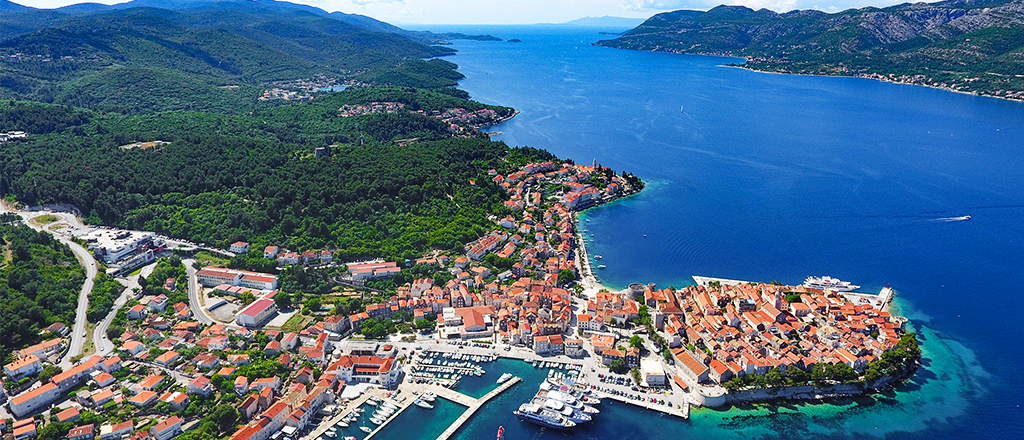
Bire Winery
Lumbarda, Island of Korčula, Dalmatia Region
About:
- Vintner Frano Milina is known both for assuring the return of the indigenous grk grape variety and for his organic production techniques. Grk disappeared from Korčula a century ago, until Milina replanted it and started making what is now his signature Bire Grk white.
Why we love it:
- A family run winery, small production and rustic charm provide guests with an authentic wine experience, and a taste of traditional Korcula.
Experiences:
- Bire Winery sits on a hillside overlooking the village of Lumbarda, the vineyards are a few miles inland. Tastings take place in a rustic stone room and include 4 wines accompanied by nibbles including house-made goat cheese and pršut (dry-cured ham).
Merga Victa
Smokvica, Island of Korčula, Dalmatia Region
About:
- Gifted enologist Igor Radovanović and Nikola Mirošević, embrace the indigenous Pošip grape, and proudly reveal its golden color and intense fruity and flowery aromas, while still managing to surprise you with a balanced and elegant finish.
Why we love it:
- Visiting the winery is to be immersed in the history of this place, and its long winemaking tradition. The freshwater ponds that feed the vineyards is where the winery takes its name, Merga Victa, meaning the path for water in old-Dalmatic. Details of winemaking and the harvest are all done in the traditional way. Grapes for the Pošip Merga Victa are selected from three different soil types (red soil, sand and rocky) to achieve the right balance. Everything in the vineyard is done manually; during the harvest grapes are picked by hand in the early morning to preserve the aromas and keep the grapes fresh.
Experiences:
- Guests can choose from four tasting options: Tasting and presentation of 3 wines alone, with complementary nibbles, or with lunch. A fourth, more elaborate option, offers a vineyard tour with tasting and presentation of 5 wines, olive oil tasting, and options for bites or lunch.
Toreta Winery
Smokvica, Island of Korčula, Dalmatia Region
About:
- This boutique, family run winery produces wines from the autochthonous varieties Pošip, Rukatac, Plavac Mali. Their work in winemaking honors tradition and history and continues as they share stories with guests. Old winemaking equipment used by the family over 100 years ago is displayed.
Why we love it:
- This winery has been completely family run by the Baničević family for four generations. Frano is the main winemaker, following in the footsteps of his father Paval, while his sister Martina is the hostess. Guests are received by their warm welcome and will learn about their family tradition of winemaking.
Experiences:
- In the tasting room next to the winery, enjoy a sampling of wines and local bites. Also available for tasting are olive oil and liquors.
Island of Hvar
Long before Hvar became internationally coveted as a premiere destination for yachting, nightlife, and glamor, the diverse landscapes found on this sunny island were home to not simply generations, but centuries, of winemakers.
Wine is back in Hvar in a big way! Young, creative vintners have been cultivating their passions for the last two decades, including the only Master of Wine in Croatia, Jo Ahearne. The result is a prolific banquet of outstanding wines.
It is said that vines were cultivated on Hvar before the arrival of the ancient Greeks in the 4th century BCE. Evidence shows, when they arrived, the Greeks brought grape vines from the island of Pharos and planted them in the fertile Stari Grad Plain, now a UNESCO World Heritage Site. The site is notable for being continuously cultivated since 400 B.C.; to this day the plots retain the divisions created by the ancient Greeks. The Romans, and later the Venetians, followed in the winemaking tradition and expanded viticulture until the Socialist era when winemaking shifted to focus on production. Another shift took place at the end of the 20th century when traditional methods met with modern equipment to produce not just outstanding, but exciting wines.
With over 2400 years of grape growing across the diverse island, 2700 hours of sunshine annually, and spectacular natural beauty, Hvar has attracted passionate and revered vintners.
Hvar is home to several indigenous varieties, both red and white wine grapes, including Mali Plavac Drnekusa, Parac, Kuc, Bogdanusa and Marastina. Many of the vineyards here, particularly those of steep limestone slopes on the southern coast, have spectacular Mediterranean views.
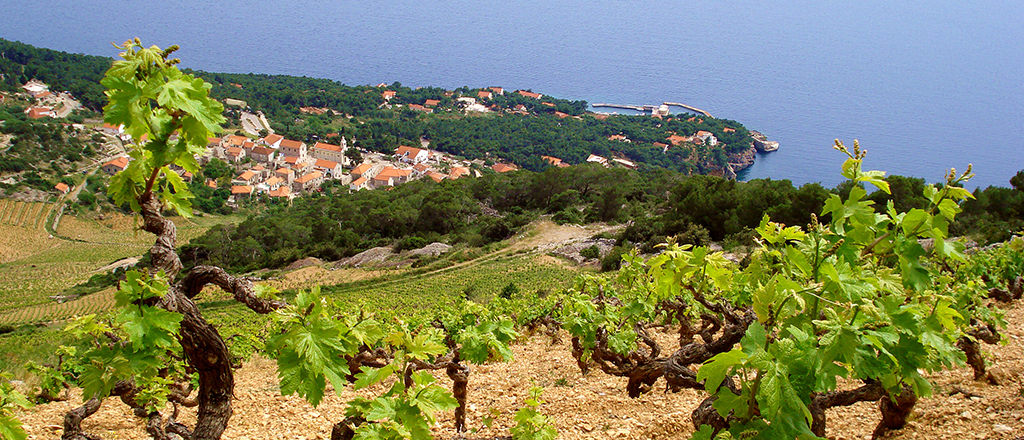
Vina Tomić
Jelsa, Island of Hvar, Dalmatia Region
About:
- Andro Tomić, the owner and main oenologist, was born on Hvar and has dedicated his life to wines and oenology. After 20 years of professional training in France and elsewhere, he decided to return to Hvar to produce his own wines. His 10 hectares of vineyards of mostly organic production are Plavac Mali, Pošip, and Bogdanuša (Given by god), as well as Cabernet Sauvignon, Cabernet Franc, Merlot, Yellow Muscat and several other varieties.
Why we love it:
- Vina Tomić embraces both tradition, and experimentation in winemaking. As Andro follows the 150-year long tradition of family winemaking, his winery’s primary aim is to produce top quality wines and promote wine culture.
Experiences:
- In Jelsa, a small coastal town with a long winemaking tradition, is the tasting venue of Vina Tomić. Modelled on ancient Roman dining rooms and carved out of stone, it resembles one of Diocletian’s cellars. They offer several wine tasting programs and create special programs to suit the interests of guests. Reservations are required.
Zlatan Otok
Sveta Nedjelja, Island of Hvar, Dalmatia Region
About:
- What began as a family farm in 1986 is now one of the most awarded winemakers in the region. There vineyards are in three distinct areas; Hvar, Makarska and Šibenik, combined between all the locations they are currently making about 16 different wines.
Why we love it:
- With over one hundred awards, medals, and recognitions of Croatia, these wines have received attention almost from the start. Zlatan Plenković built what is one of Croatia’s greatest wine success stories, while maintaining a dedication to quality, handpicked, low yield and organic viticulture. Mr. Plenkovic was honored as Croatian winemaker of the year until 2009, when he was name as Croatian wine knight, after which he could no longer compete for the title. Mr. Plenković died in March 2016 and the winery is now operated by his children Nikola, Marin and Antonia.
Experiences:
- A variety of tastings are offered in their restaurant, Bilo idro, which sits in small marina in Sveta Nedjelja and serves fresh seafood and Dalmatian fare. Guests can arrive by car or by boat to this tiny fishing village, resting below a dramatic mountain slope. Following tastings or lunch, tour the underwater wine cellar.
Vina Ahearne
Vrisnik,Island of Hvar, Dalmatia Region
About:
- Winemaker and Master of Wine Jo Ahearne, originally a Londoner, has made wines in Bordeaux, Burgundy, and Australia, but upon visiting Hvar was so captivated by the potential of the island that she set up her winery here in 2014.
Why we love it:
- The winery specializes in local Dalmatian varieties that represent the region and rocky landscape. Currently producing five wines: a rosé, two whites (Pošip and a maceration wine), a multi vintage blend made to echo the delicacy of a Pinot Noir, and a barrique-aged Plavac Mali. Her rosé is made with a near-extinct variety, Darnekuša. Read more about her unique winemaking style in a Forbes article from 2019.
Experiences:
- Experience a wine tasting in the hidden, hilltop village of Vrisnik; lasts around 45 minutes. Guests will taste some world-class Ahearne wines with Jo and get insight into the fine heritage of the Hvar winemaking tradition. Additional option for joining Jo in a masterclass of winemaking techniques and in-depth wine tasting experience, learning the techniques Jo uses to add her specific twist and how the terroir of the island defines the wines.
Split / Šibenik
Many of our guests spend time in Split as it is home to an international airport and makes a convenient starting point for charters and visits to the islands of southern Dalmatia, but the most important reason we bring our guests to Split is because it is truly amazing.
The Roman emperor Diocletian made his summer residence here in the 4th century. Today the site is one of the best-preserved monuments of Roman architecture in Europe. The entire historical Complex of Split, with the Palace of Diocletian, was listed by UNESCO as a World Heritage site in 1979. Today, it combines with ruins and monuments to form the heart of this vibrant city.
The waterfront Riva, lined with eateries and palm trees, adjacent to a of bevy of ships bobbing gently in the water, evokes a Mediterranean paradise. No wineries reside within the city limits of Split, however, we offer here below our selections for wineries in the area which we highly recommend. While visiting wineries in the region, we advise guests to spend a day pairing the winery visit with other activities outside the city, to which we will make personal suggestions based on personal interests.
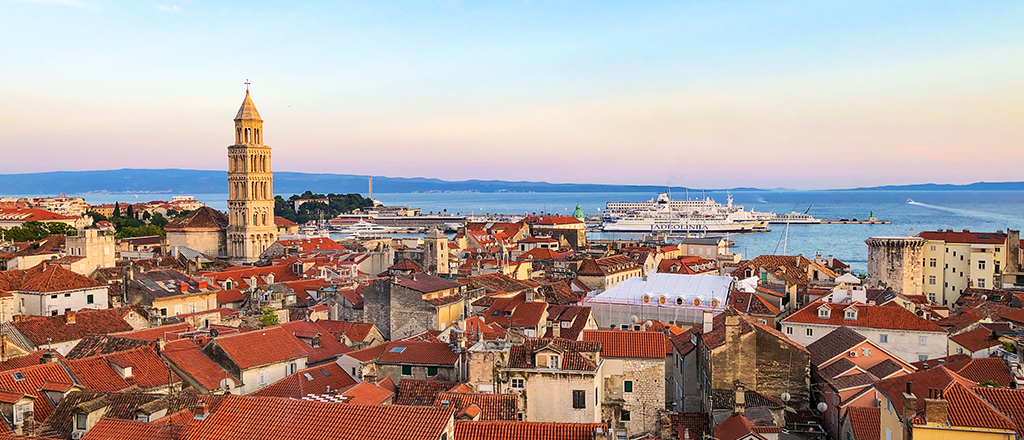
Testament Winery
Šibenik, Northern Dalmatia Region
About:
- Testament winery focuses on indigenous Dalmatian grapes, picked early for freshness with a minimalistic approach to winemaking. Winemaker, Juraj Sladić, has used the process of wine aged under the sea, thought to produce the equivalent of 18 months of aging due to underwater pressure, which possibly produces finer tannins.
Why we love it:
- Visiting Testament is a Dalmatian experience. The tasting room is in the middle of their organic hillside vineyard with a beautiful view. Juraj, the winemaker is often stopping to say hello to guests.
Experiences:
- Three tasting options, each guided. The first is with 3 wines and tasting bites lasting 90 minutes, while the others include lunch and last 180 minutes. Option 2 presents a tasting of three wines severed with a lite lunch, and option 3 is a tasting of four wines with 4 course lunch. All are guided, and menu is seasonal. Closed Sunday.
BIBICh Winery
Plastovo, Skradin, Northern Dalmatia Region
About:
- A selection of premium Croatian wines produced from a variety of grapes including Babic, Debit, Grenache Noir, Shiraz, Posip, Plavina, Merlot, Pinot Grigio and Marastina.
Why we love it:
- BIBICh winery is a gem of Northern Dalmatia. The exquisite tasting room, and beautiful warm garden are the perfect setting for your afternoon wine tastings. Hosts Alen & Vesna Bibić have created an experiential delight for their guests. We love the dry white wine, Bas de Bas, produced from Debit grapes using a thousand-year-old tradition with long maceration and fermentation in stone barrels.
Experiences:
- Tasting room, garden, and cellar tours are available, but for a truly one of a kind gourmet experience, make reservations to dine at Bibich. Read more about the immersive culinary & wine pairing options here.







